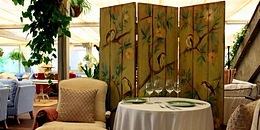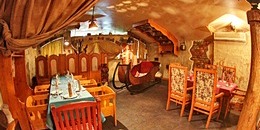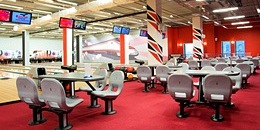Karpovka River
This river flows along the Petrograd Side and divides the Petrogradsky and Aptekarsky Islands. The most attractive stretch of the Karpovka runs between the St. John of Rila Convent and the St. Petersburg Botanical Garden. Here the curving, leafy granite embankments provide a perfect setting for several excellent examples of the Northern Moderne for which the Petrograd Side is famous.

The name of the river dates back to the earliest years of the city and beyond. It is the result of the mispronunciation of the Finnish word "Korpiyoki" which means "river in the woods" or "crow-river." Some, however, associated the name of the river with carp that once swam here, but this is unlikely as the Karpovka River was very silted until the middle of the 20th century and had constantly crumbling banks. It was not until 1960-1970 that the shore was partly reinforced with granite embankments.

There are several interesting building along the banks of the Karpovka River. The most famous is the St. John of Rila Convent. It was founded in 1900 by the widely revered priest St. John of Kronstadt. The ornate neo-Byzantine building was designed by the great church architect Nikolay Nikonov. John of Kronstadt is himself buried here, and pilgrims from around the world have flocked to visit his grave for over one hundred years.

On Karpovka Embankment at no. 13, the curved concrete building set back from the river is the First Residential Building of the Leningrad Sovier. Built in 1931-1935 by the well-known Soviet architects Ivan Fomin and Evgeny Levinson it was one the last and best works of constructivism in the city. Unlike previous constructivist housing developments it was built for the Bolshevik elite, which meant that hight quality building materials were used, and the large and luxuriously fitted apartments are still considered highly desirable. At the beginning of the 18th century, the wooden mansion of Theophan Prokopovich stood on the left bank of Karpovka at no. 4. Prokopovich was an influential Russian Bishop and an associate of Peter the Great who helped the Tsar reform the Orthodox Church. A great promoter of education who believed that ignorance and superstition were the greatest evils, Prokopovich established a school for "orphans of all ranks" in his house. In 1835, the house became the Ss. Peter and Paul Hospital, which eventually grew into the St. Petersburg State Medical University. On the right bank of the river opposite the hospital is the Botanical Garden.

Seven bridges currently stretch across the Karpovka River, the oldest of which are the Aptekarsky and Silin Bridges. The Aptekarsky Bridge was built in 1798 and rebuilt in 1974. Its current width is 96 meters, making it the second widest bridge in St. Petersburg after the Blue Bridge. The Silin bridge was built of wood in 1776. In 1936, a modern single-span concrete bridge was built in its place. Pleasure boats do not sail along the Karpovka, but it is possible to charter a boat for the trip.
| Metro stations: | Petrogradskaya |
|---|---|
| Characteristics of the river: | Length: 3 kilometers Width: 20 meters |
| What's here? | Petropavlosky Bridge, Aptekarsky Bridge, Silin Bridge |







